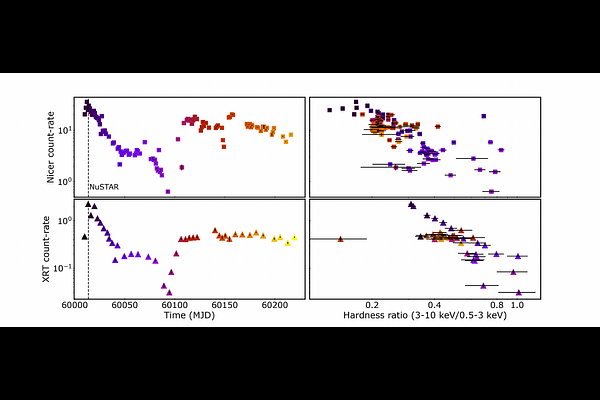On the nature of the X-ray binary transient MAXI J1834-021: clues from its first observed outburst

On the nature of the X-ray binary transient MAXI J1834-021: clues from its first observed outburst
A. Manca, A. Marino, A. Borghese, F. Coti Zelati, G. Mastroserio, A. Sanna, J. Homan, R. Connors, M. Del Santo, M. Armas Padilla, T. Muñoz-Darias, T. Di Salvo, N. Rea, J. A. García, A. Riggio, M. C. Baglio, L. Burderi
AbstractMAXI J1834-021 is a new X-ray transient that was discovered in February 2023. We analysed the spectral and timing properties of MAXI J1834-021 using NICER, NuStar and Swift data collected between March and October 2023. The light curve showed a main peak followed by a second activity phase. The majority of the spectra extracted from the individual NICER observations could be adequately fitted with a Comptonisation component alone, while a few of them required an additional thermal component. The spectral evolution is consistent with a softening trend as the source gets brighter in X-rays. We also analysed the broadband spectrum combining data from simultaneous NICER and NuStar observations on 2023 March 10. This spectrum can be fitted with a disc component with a temperature at the inner radius of $kT_{\rm in} \sim 0.4$ keV and a Comptonisation component with a power-law photon index of $\Gamma \sim 1.8$. By including a reflection component in the modelling, we obtained a 3$\sigma$ upper limit for the inner disc radius of 11.4 gravitational radii. We also detected a quasi-periodic oscillation (QPO), whose central frequency varies with time (from 2 Hz to $\sim$0.9 Hz) and anti-correlates with the hardness ratio. Based on the observed spectral-timing properties, MAXI J1834-021, can be classified as a low-mass X-ray binary in outburst. However, we are not able to draw a definitive conclusion on the nature of the accreting compact object, which at the moment could as well be a black hole or a neutron star.